Voltage divider
circuits
Let's analyze a simple series circuit,
determining the voltage drops across individual resistors:


From the given values of individual
resistances, we can determine a total circuit resistance,
knowing that resistances add in series:

From here, we can use Ohm's Law (I=E/R) to
determine the total current, which we know will be the same
as each resistor current, currents being equal in all parts
of a series circuit:

Now, knowing that the circuit current is 2
mA, we can use Ohm's Law (E=IR) to calculate voltage across
each resistor:

It should be apparent that the voltage drop
across each resistor is proportional to its resistance,
given that the current is the same through all resistors.
Notice how the voltage across R2 is double that
of the voltage across R1, just as the resistance
of R2 is double that of R1.
If we were to change the total voltage, we
would find this proportionality of voltage drops remains
constant:

The voltage across R2 is still
exactly twice that of R1's drop, despite the fact
that the source voltage has changed. The proportionality of
voltage drops (ratio of one to another) is strictly a
function of resistance values.
With a little more observation, it becomes
apparent that the voltage drop across each resistor is also
a fixed proportion of the supply voltage. The voltage across
R1, for example, was 10 volts when the battery
supply was 45 volts. When the battery voltage was increased
to 180 volts (4 times as much), the voltage drop across R1
also increased by a factor of 4 (from 10 to 40 volts). The
ratio between R1's voltage drop and total
voltage, however, did not change:

Likewise, none of the other voltage drop
ratios changed with the increased supply voltage either:
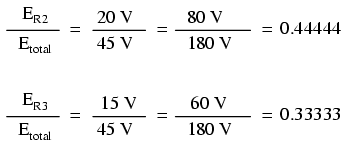
For this reason a series circuit is often
called a voltage divider for its ability to
proportion -- or divide -- the total voltage into fractional
portions of constant ratio. With a little bit of algebra, we
can derive a formula for determining series resistor voltage
drop given nothing more than total voltage, individual
resistance, and total resistance:
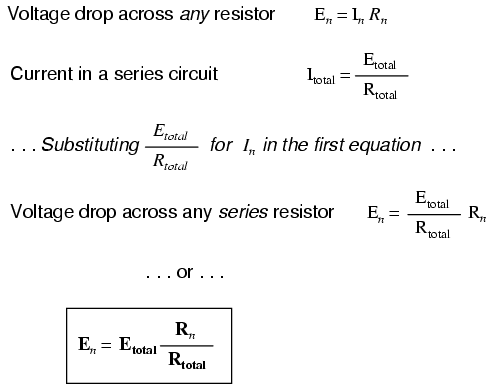
The ratio of individual resistance to total
resistance is the same as the ratio of individual voltage
drop to total supply voltage in a voltage divider circuit.
This is known as the voltage divider formula, and it
is a short-cut method for determining voltage drop in a
series circuit without going through the current
calculation(s) of Ohm's Law.
Using this formula, we can re-analyze the
example circuit's voltage drops in fewer steps:

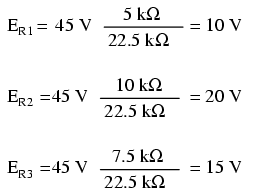
Voltage dividers find wide application in
electric meter circuits, where specific combinations of
series resistors are used to "divide" a voltage into precise
proportions as part of a voltage measurement device.
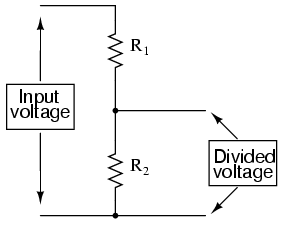
One device frequently used as a
voltage-dividing component is the potentiometer,
which is a resistor with a movable element positioned by a
manual knob or lever. The movable element, typically called
a wiper, makes contact with a resistive strip of
material (commonly called the slidewire if made of
resistive metal wire) at any point selected by the manual
control:
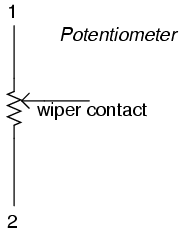
The wiper contact is the left-facing arrow
symbol drawn in the middle of the vertical resistor element.
As it is moved up, it contacts the resistive strip closer to
terminal 1 and further away from terminal 2, lowering
resistance to terminal 1 and raising resistance to terminal
2. As it is moved down, the opposite effect results. The
resistance as measured between terminals 1 and 2 is constant
for any wiper position.
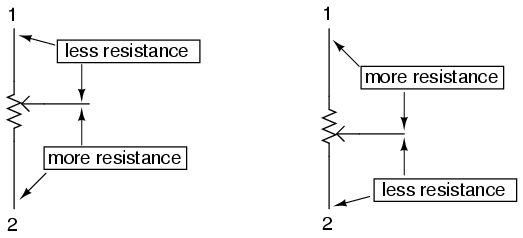
Shown here are internal illustrations of two
potentiometer types, rotary and linear:
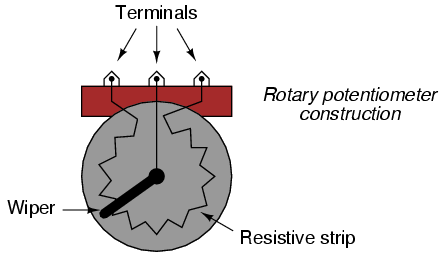
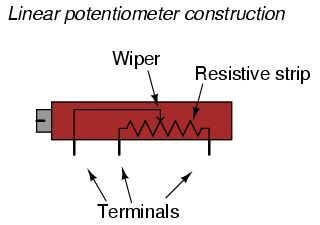
Some linear potentiometers are actuated by
straight-line motion of a lever or slide button. Others,
like the one depicted in the previous illustration, are
actuated by a turn-screw for fine adjustment ability. The
latter units are sometimes referred to as trimpots,
because they work well for applications requiring a variable
resistance to be "trimmed" to some precise value. It should
be noted that not all linear potentiometers have the same
terminal assignments as shown in this illustration. With
some, the wiper terminal is in the middle, between the two
end terminals.
The following photograph shows a real,
rotary potentiometer with exposed wiper and slidewire for
easy viewing. The shaft which moves the wiper has been
turned almost fully clockwise so that the wiper is nearly
touching the left terminal end of the slidewire:
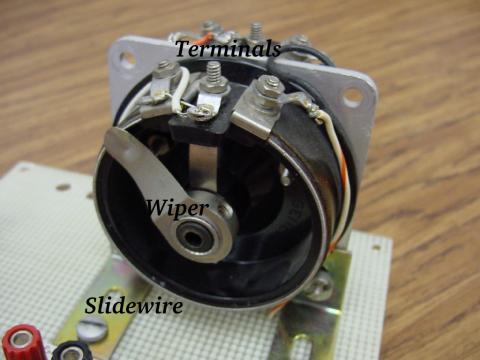
Here is the same potentiometer with the
wiper shaft moved almost to the full-counterclockwise
position, so that the wiper is near the other extreme end of
travel:
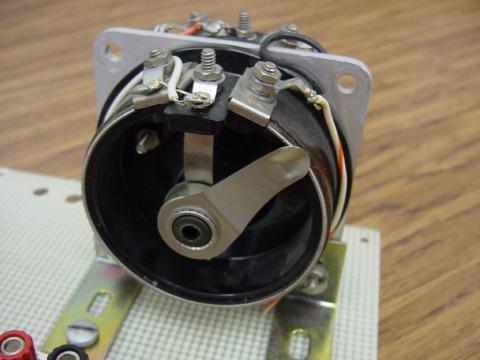
If a constant voltage is applied between the
outer terminals (across the length of the slidewire), the
wiper position will tap off a fraction of the applied
voltage, measurable between the wiper contact and either of
the other two terminals. The fractional value depends
entirely on the physical position of the wiper:
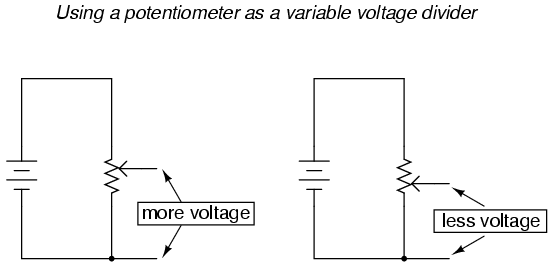
Just like the fixed voltage divider, the
potentiometer's voltage division ratio is strictly a
function of resistance and not of the magnitude of applied
voltage. In other words, if the potentiometer knob or lever
is moved to the 50 percent (exact center) position, the
voltage dropped between wiper and either outside terminal
would be exactly 1/2 of the applied voltage, no matter what
that voltage happens to be, or what the end-to-end
resistance of the potentiometer is. In other words, a
potentiometer functions as a variable voltage divider where
the voltage division ratio is set by wiper position.
This application of the potentiometer is a
very useful means of obtaining a variable voltage from a
fixed-voltage source such as a battery. If a circuit you're
building requires a certain amount of voltage that is less
than the value of an available battery's voltage, you may
connect the outer terminals of a potentiometer across that
battery and "dial up" whatever voltage you need between the
potentiometer wiper and one of the outer terminals for use
in your circuit:
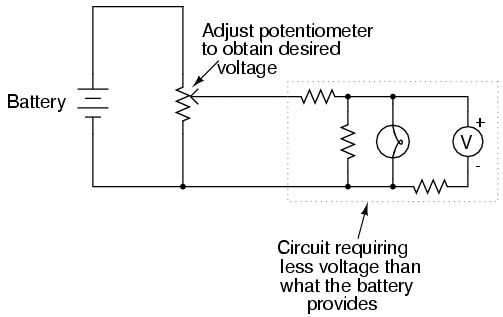
When used in this manner, the name
potentiometer makes perfect sense: they meter
(control) the potential (voltage) applied across them
by creating a variable voltage-divider ratio. This use of
the three-terminal potentiometer as a variable voltage
divider is very popular in circuit design.
Shown here are several small potentiometers
of the kind commonly used in consumer electronic equipment
and by hobbyists and students in constructing circuits:
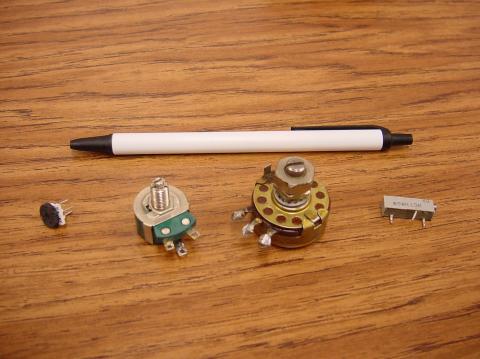
The smaller units on the very left and very
right are designed to plug into a solderless breadboard or
be soldered into a printed circuit board. The middle units
are designed to be mounted on a flat panel with wires
soldered to each of the three terminals.
Here are three more potentiometers, more
specialized than the set just shown:
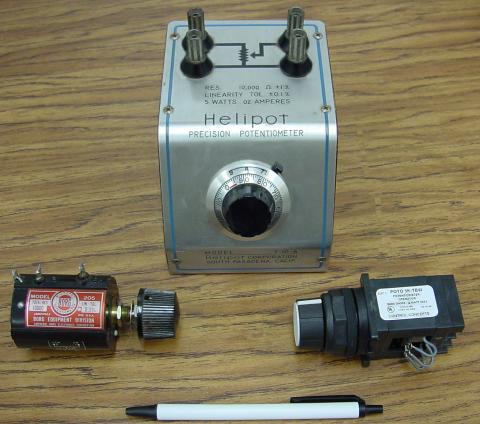
The large "Helipot" unit is a laboratory
potentiometer designed for quick and easy connection to a
circuit. The unit in the lower-left corner of the photograph
is the same type of potentiometer, just without a case or
10-turn counting dial. Both of these potentiometers are
precision units, using multi-turn helical-track resistance
strips and wiper mechanisms for making small adjustments.
The unit on the lower-right is a panel-mount potentiometer,
designed for rough service in industrial applications.
-
REVIEW:
-
Series circuits proportion, or divide,
the total supply voltage among individual voltage drops,
the proportions being strictly dependent upon resistances:
ERn = ETotal (Rn / RTotal)
-
A potentiometer is a variable-resistance
component with three connection points, frequently used as
an adjustable voltage divider
|